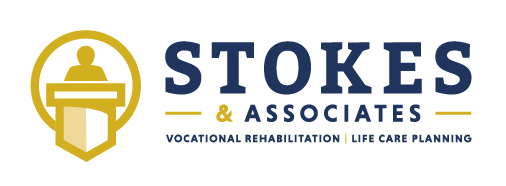Determining Wage Earning Capacity with Limited or No Work History
Determining loss of earning capacity for an individual with limited or no work history often involves considering various scenarios and determining what is more probable and reasonable given the particular context. More often than not, these cases involve younger individuals who have not developed a strong work history.
As an example of how our vocational experts handle situations like this, consider the case of John Jones, who at 18-years old required a below-the-knee amputation. Mr. Jones was fitted for a custom prosthetic and is permanently restricted to sedentary to light activities, with a maximum lifting ability of 35 pounds.
Since Mr. Jones was injured before he had an opportunity to establish a career path, his vocational profile is developed based upon his physical restrictions, sedentary to light activities, and the results of his vocational testing, which indicated average achievement in reading and below average achievement in math.
Without historically documented earnings to arrive at his pre-injury earning capacity scenarios are considered based on his age, family history, educational level, academic functioning, functional limitations, and his interests and goals for the future.
Strategy 1: Socio-Economic Status - Based on the educational levels and professional accomplishments of Mr. Jones’s family members. In this scenario, it is also important to consider the likelihood of advancement in an individual’s career, particularly given Mr. Jones’s young age.
Strategy 2: Potential for Intermediate Education - Based on Mr. Jones’s short-term educational and vocational goals.
Strategy 3: Potential for Advanced Education - Based on Mr. Jones’s long-term educational and vocational goals.
Strategy 4: Direct Job Access - Based on Mr. Jones’s demographic characteristics and geographic area.
Mr. Jones’s post-injury earning capacity is dependent on a) his ability to complete his Associate’s degree and those corresponding earnings; b) if not able to complete his degree, he will compete for employment with other individuals with a high school diploma and no work experience and such earnings.
Finally, we determine the loss of earning capacity Mr. Jones has experienced as a result of the injuries he sustained. In Mr. Jones’s case, the loss of earning capacity is dependent on educational attainment. After we complete the vocational analysis, the earnings data can be supplied to an economist who calculates the expected loss of earnings capacity over the individual’s work life expectancy.
We offer complimentary consultations concerning "hypothetical matters."
To strategize with one of our vocational experts or life care plan experts at Stokes & Associates, Inc. please call David Barrett at 504-454-5009, visit our website, www.stokes-associates.com or email dbarrett@stokes-associates.com.
Larry S. Stokes, Ph.D.
Aaron Wolfson, Ph.D.
Lacy Sapp, MHS, CRC, LPC, LRC, CLCP
Todd Capielano, M.Ed., LRC, CRC, LPC, CLCP
